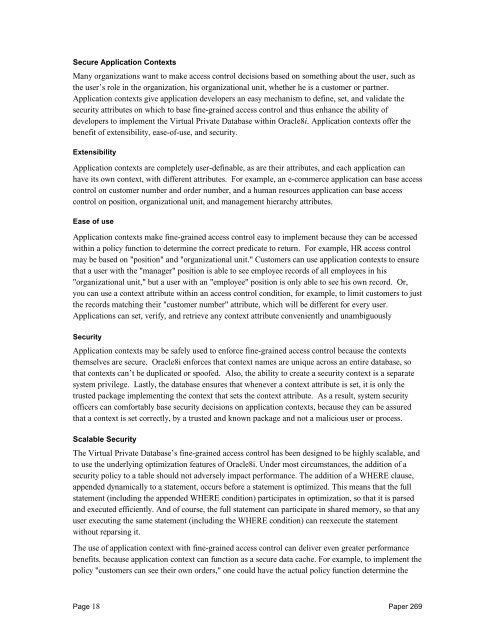Oracle 8i Security: New Features and Secure Solutions - CGISecurity
Oracle 8i Security: New Features and Secure Solutions - CGISecurity
Oracle 8i Security: New Features and Secure Solutions - CGISecurity
You also want an ePaper? Increase the reach of your titles
YUMPU automatically turns print PDFs into web optimized ePapers that Google loves.
<strong>Secure</strong> Application Contexts<br />
Many organizations want to make access control decisions based on something about the user, such as<br />
the user’s role in the organization, his organizational unit, whether he is a customer or partner.<br />
Application contexts give application developers an easy mechanism to define, set, <strong>and</strong> validate the<br />
security attributes on which to base fine-grained access control <strong>and</strong> thus enhance the ability of<br />
developers to implement the Virtual Private Database within <strong>Oracle</strong><strong>8i</strong>. Application contexts offer the<br />
benefit of extensibility, ease-of-use, <strong>and</strong> security.<br />
Extensibility<br />
Application contexts are completely user-definable, as are their attributes, <strong>and</strong> each application can<br />
have its own context, with different attributes. For example, an e-commerce application can base access<br />
control on customer number <strong>and</strong> order number, <strong>and</strong> a human resources application can base access<br />
control on position, organizational unit, <strong>and</strong> management hierarchy attributes.<br />
Ease of use<br />
Application contexts make fine-grained access control easy to implement because they can be accessed<br />
within a policy function to determine the correct predicate to return. For example, HR access control<br />
may be based on "position" <strong>and</strong> "organizational unit." Customers can use application contexts to ensure<br />
that a user with the "manager" position is able to see employee records of all employees in his<br />
"organizational unit," but a user with an "employee" position is only able to see his own record. Or,<br />
you can use a context attribute within an access control condition, for example, to limit customers to just<br />
the records matching their "customer number" attribute, which will be different for every user.<br />
Applications can set, verify, <strong>and</strong> retrieve any context attribute conveniently <strong>and</strong> unambiguously<br />
<strong>Security</strong><br />
Application contexts may be safely used to enforce fine-grained access control because the contexts<br />
themselves are secure. <strong>Oracle</strong><strong>8i</strong> enforces that context names are unique across an entire database, so<br />
that contexts can’t be duplicated or spoofed. Also, the ability to create a security context is a separate<br />
system privilege. Lastly, the database ensures that whenever a context attribute is set, it is only the<br />
trusted package implementing the context that sets the context attribute. As a result, system security<br />
officers can comfortably base security decisions on application contexts, because they can be assured<br />
that a context is set correctly, by a trusted <strong>and</strong> known package <strong>and</strong> not a malicious user or process.<br />
Scalable <strong>Security</strong><br />
The Virtual Private Database’s fine-grained access control has been designed to be highly scalable, <strong>and</strong><br />
to use the underlying optimization features of <strong>Oracle</strong><strong>8i</strong>. Under most circumstances, the addition of a<br />
security policy to a table should not adversely impact performance. The addition of a WHERE clause,<br />
appended dynamically to a statement, occurs before a statement is optimized. This means that the full<br />
statement (including the appended WHERE condition) participates in optimization, so that it is parsed<br />
<strong>and</strong> executed efficiently. And of course, the full statement can participate in shared memory, so that any<br />
user executing the same statement (including the WHERE condition) can reexecute the statement<br />
without reparsing it.<br />
The use of application context with fine-grained access control can deliver even greater performance<br />
benefits. because application context can function as a secure data cache. For example, to implement the<br />
policy "customers can see their own orders," one could have the actual policy function determine the<br />
Page 18 Paper 269










